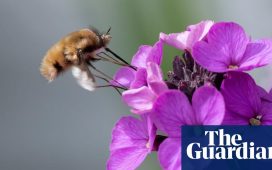The Victorian naturalist Alfred Russel Wallace once called feathers “the masterpiece of nature” and “the perfectest venture imaginable”. Grammar aside, you can see what he meant.
The obvious expression of it is their gift of flight. Take the young swifts flashing over our garden. Once fledged and free of their nests, they may not land until they themselves breed two years hence. They may be on the wing, here or over Africa, for 22 months, flying 500,000km and more.
Such feats don’t even begin to explore the power of feathers as insulation. Yet they have enabled birds, as represented by emperor penguins, to breed during the Antarctic winter, sitting on a single egg in temperatures as low as -70C. All of this is highly impressive – unlike, it must be said, the feathers on the blackbird in my garden.

In the roaring temperatures last week she took to stretching flat on the ground, beak wide open, head cocked fractionally to one side, crown feathers lifted, wings splayed, tail spread and her body plumage fluffed up like a feather duster. At her rear there is a flash of the bare pink skin on the pygostyle – the “parson’s nose” on a plucked chicken – which evokes the scrawny and naked dinosaur hidden beneath all that scruffy plumage.
The action may look strange, but it takes an even more bizarre form in wood pigeons, which occasionally lie alongside the blackbird, panting incessantly, wings raised like flags, and the whole creature slumped and looking as helpless as if it had just taken a load of buckshot. In truth this behaviour, which is highly seasonal, is performed by many birds as a sort of therapy.
It is often referred to as “sunbathing” but it is intended to counter one of birds’ best-kept secrets – the burden of louse flies, mites and chewing lice, the fungi and the bacteria that live in the warm moist conditions of the body down, where they eat the feathers. More than 150 species of invertebrate ectoparasite are known, and a single bird may have 12 varieties in its feathers; by exposing them to direct sunlight it reduces their effects.













